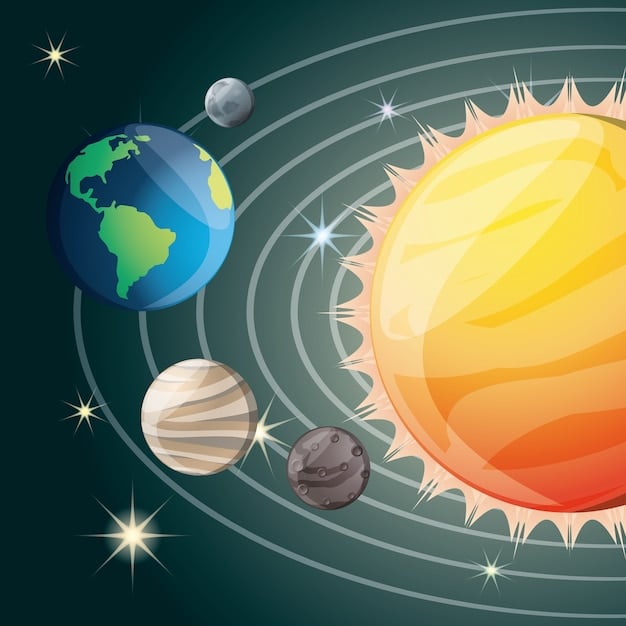2025 Solstices & Equinoxes: Dates and Spiritual Meaning

The 2025 solstices and equinoxes mark key astronomical events, occurring on specific dates that influence Earth’s seasons and hold deep spiritual and cultural significance, symbolizing balance, renewal, and transition in various traditions worldwide.
Are you ready to mark your calendar with the significant cosmic events of the coming year? Join us as we explore the dates and spiritual significance of the 2025’s Solstices and Equinoxes: Dates and Their Spiritual Significance, offering insights into how these celestial events impact both our planet and our personal lives.
Understanding the Basics: Solstices and Equinoxes Defined
Solstices and equinoxes are pivotal moments in Earth’s yearly journey around the sun. They are astronomical events that dictate our seasons and have been observed and celebrated by cultures worldwide for millennia. Let’s delve into what these terms actually mean.
The term ‘solstice’ comes from the Latin words “sol” (sun) and “sistere” (to stand still). It signifies the point when the sun reaches its highest or lowest excursion relative to the celestial equator on the celestial sphere. This results in the longest and shortest days of the year. On the other hand, ‘equinox’ is derived from the Latin “aequus” (equal) and “nox” (night), marking the time when day and night are of nearly equal length all over the planet.
Why Do They Occur?
These events occur due to Earth’s axial tilt of approximately 23.5 degrees. This tilt causes different parts of the Earth to receive more direct sunlight at different times of the year, leading to the seasons and the distinct experiences of solstices and equinoxes. Without this tilt, we wouldn’t experience the rich variety of seasons, nor would these celestial events carry the significance they do.
Understanding the science behind these events allows us to appreciate their impact not only on our environment but also on cultural and spiritual practices that have evolved around them. This sets the stage for further exploring the specific dates and meanings of the 2025 solstices and equinoxes.

Key Differences Between Solstices and Equinoxes
- Solstices: Represent extreme points in the solar cycle, with the summer solstice marking the longest day and the winter solstice the shortest.
- Equinoxes: Symbolize balance and transition, as day and night are nearly equal, heralding the arrival of spring and autumn.
- Sunlight Distribution: During solstices, one hemisphere receives maximum sunlight while the other receives minimal. Equinoxes see a more even distribution of sunlight across both hemispheres.
In conclusion, these astronomical events define our year and have deep-rooted effects on our planet. Recognizing their distinct properties enriches our understanding and appreciation of the cosmos.
2025 Dates: Marking Your Calendar
Knowing the exact dates of the solstices and equinoxes in 2025 helps us align with the natural rhythms of the Earth. These moments aren’t just astronomical occurrences; they’re temporal markers that influence our seasons and cultural celebrations.
Here are the dates you’ll want to note down for the 2025 solstices and equinoxes:
- Spring Equinox: March 20, 2025
- Summer Solstice: June 21, 2025
- Autumn Equinox: September 22, 2025
- Winter Solstice: December 21, 2025
These dates are based on Coordinated Universal Time (UTC), so they might vary slightly depending on your local time zone. Marking these dates on your calendar allows you to anticipate and celebrate these celestial events, connecting you more deeply with the natural world.
Tips for Tracking Astronomical Events
Keeping track of solstices and equinoxes can be made easier with a few handy resources and tips. From digital tools to traditional methods, there are numerous ways to stay informed and connected with these events.
- Use Online Calendars: Many online calendars automatically update with astronomical events. Google Calendar, for instance, allows you to add solstices and equinoxes to your schedule.
- Download Astronomy Apps: Apps like SkyView Lite or Star Walk can provide real-time information about celestial events and send notifications when solstices and equinoxes occur.
- Follow Astronomy Websites: Websites like TimeandDate.com offer precise dates and times for these events, adjusted to your local time zone.
By adopting these approaches, you can remain informed and engaged with the rhythm of the seasons, enriching your appreciation of the cosmos.
Understanding these dates not only grounds us in the present but also allows us to consider the historical and cultural contexts in which these astronomical events have been celebrated for centuries.
Spiritual Significance Across Cultures
The spiritual significance of solstices and equinoxes transcends mere dates; they are deeply interwoven with various cultural traditions and spiritual beliefs worldwide. These celestial events have inspired rituals, festivals, and myths, reflecting humanity’s enduring connection to the cosmos.
Across cultures, solstices and equinoxes often symbolize turning points, renewal, and balance. These moments are seen as opportunities for reflection, celebration, and spiritual growth. Let’s explore some specific examples of how different cultures honor these occasions.
- Summer Solstice (Midsummer): In many European traditions, the summer solstice is celebrated with bonfires, feasts, and gatherings. It symbolizes the peak of the sun’s power and the abundance of nature.
- Winter Solstice (Yule): Celebrated by Germanic peoples, Yule marks the return of the sun after the longest night. It is a time for feasting, gift-giving, and honoring ancestors.
- Spring Equinox (Ostara): In Pagan traditions, Ostara celebrates the balance between light and darkness, heralding new beginnings and fertility.
- Autumn Equinox (Mabon): Mabon is a harvest festival, giving thanks for the bounty of the Earth and preparing for the darker months ahead.
By understanding these cultural contexts, we can appreciate the profound ways in which solstices and equinoxes shape our spiritual and communal lives. These celebrations remind us of our shared human experience and our connection to the natural world.

The Role of Solstices and Equinoxes in Modern Spirituality
Even in our modern world, solstices and equinoxes continue to hold spiritual weight for many individuals. These events provide a moment to pause, reflect, and realign with personal values and intentions.
Many people incorporate solstice and equinox events into their mindfulness practices, setting intentions for the coming season or engaging in rituals that honor the Earth and the cycles of nature. Here are some common practices:
- Meditation: Guided meditations focused on themes of balance, renewal, and gratitude.
- Nature Walks: Spending time outdoors, connecting with the natural world and observing the changing seasons.
- Journaling: Reflecting on personal goals, achievements, and areas for growth, aligned with the energy of the season.
In essence, the modern spiritual significance of solstices and equinoxes lies in their ability to provide a rhythm for personal growth and reflection, connecting us to both our inner selves and the larger world.
Through understanding and engaging with these traditions, we can cultivate a deeper sense of connection and appreciation for the cosmos and our place within it.
Astrological Influences of Solstices and Equinoxes
In astrology, solstices and equinoxes mark key shifts in the zodiac calendar, each associated with specific energies and astrological signs that influence personal and collective experiences. Understanding these influences can provide valuable insights into how these celestial events affect our lives.
Each solstice and equinox corresponds with the entry of the sun into a cardinal sign, which signifies new beginnings and assertive energy. Let’s examine these associations:
- Spring Equinox: Marks the entry of the sun into Aries, the first sign of the zodiac, symbolizing initiation, courage, and action.
- Summer Solstice: Corresponds with the sun entering Cancer, a water sign associated with emotions, family, and nurturing.
- Autumn Equinox: Occurs when the sun enters Libra, an air sign focused on balance, harmony, and relationships.
- Winter Solstice: Aligns with the sun entering Capricorn, an earth sign that emphasizes structure, discipline, and long-term goals.
These astrological alignments provide a framework for understanding the energies at play during each solstice and equinox, offering opportunities for personal reflection and alignment with cosmic forces.
How to Harness Astrological Energies
By understanding the astrological significance of solstices and equinoxes, we can consciously harness these energies to enhance our personal growth and well-being. Here are some practical ways to align with the astrological influences of each event:
- Spring Equinox (Aries): Set bold intentions, take initiative on new projects, and embrace your inner courage.
- Summer Solstice (Cancer): Focus on emotional well-being, nurture relationships with loved ones, and create a comfortable home environment.
- Autumn Equinox (Libra): Seek balance in all areas of life, prioritize harmony in relationships, and practice diplomacy.
- Winter Solstice (Capricorn): Establish clear goals, commit to long-term plans, and cultivate discipline.
By consciously aligning with these astrological energies, we can make the most of the transformative potential of solstices and equinoxes, fostering personal growth and alignment with the cosmos.
Therefore, understanding the astrological influences of solstices and equinoxes provides a richer context for appreciating their significance and incorporating their energies into our lives.
Celebrating the Seasons: Rituals and Practices
Celebrating solstices and equinoxes through rituals and practices is an enriching way to connect with the cycles of nature and honor the changing seasons. These practices can range from simple personal reflections to elaborate communal celebrations.
Engaging in seasonal rituals provides an opportunity to slow down, reflect on our lives, and align with the rhythms of the Earth. Whether you prefer solitary practices or group gatherings, there are numerous ways to honor the solstices and equinoxes. Here are some suggestions:
Seasonal Ritual Ideas
- Creating an Altar: Decorate an altar with seasonal symbols such as flowers, candles, stones, and herbs to honor the spirit of the season.
- Nature Walks: Spend time outdoors, immersing yourself in nature and observing the changing landscape.
- Fire Ceremonies: Light a bonfire or candles to symbolize the sun’s power and the renewal of life.
- Harvest Festivals: Gather with friends and family to share a meal made with seasonal ingredients, celebrating the abundance of the Earth.
- Intention Setting: Reflect on your goals and set intentions for the coming season.
By incorporating these rituals into our celebrations, we can deepen our connection to the natural world and enrich our spiritual lives.
Personal Practices for Seasonal Alignment
In addition to seasonal rituals, there are numerous personal practices that can help us align with the energies of solstices and equinoxes. These practices encourage mindfulness, reflection, and connection with our inner selves.
- Mindful Meditation: Practice mindfulness meditation to cultivate awareness of the present moment and connect with your inner self.
- Gratitude Journaling: Reflect on the things you are grateful for and express gratitude for the blessings in your life.
- Creative Expression: Engage in creative activities such as painting, writing, or music to express your emotions and connect with your inner muse.
By incorporating these personal practices into our daily lives, we can cultivate a deeper sense of connection with the cycles of nature and enhance our overall well-being.
Celebrating the seasons through rituals and practices is a powerful way to honor the solstices and equinoxes, connect with nature, and enrich our spiritual lives.
Looking Ahead: The Significance of 2025
As we approach 2025, understanding the dates and spiritual significance of the solstices and equinoxes allows us to prepare for the year ahead with intention and awareness. These celestial events provide a framework for personal reflection, seasonal celebrations, and connection to the natural world.
By marking these dates on our calendars and incorporating seasonal rituals into our lives, we can align with the rhythms of the Earth and enhance our overall well-being. The solstices and equinoxes serve as reminders of the cyclical nature of life and the importance of embracing change, balance, and renewal.
Practical Tips for Planning Ahead
Looking ahead to 2025, here are some practical tips for planning your celebrations and activities around the solstices and equinoxes:
- Mark the Dates: Add the dates of the solstices and equinoxes to your calendar and set reminders to ensure you don’t miss them.
- Plan Celebrations: Organize gatherings with friends and family, plan outdoor activities, or create personal rituals to honor the season.
- Set Intentions: Take time to reflect on your goals and set intentions for the coming season, aligning with the energies of the event.
By planning ahead, you can make the most of these celestial events and create meaningful experiences that enhance your connection to the cosmos.
Embracing the Journey
As we journey through 2025, let us embrace the solstices and equinoxes as opportunities for personal growth, seasonal celebrations, and connection to the natural world. By honoring these celestial events, we can cultivate a deeper sense of appreciation for the rhythms of life and our place within the cosmos.
Through understanding the dates and spiritual significance of these events, we are better equipped to navigate the year with intention, awareness, and a profound connection to the world around us.
| Key Point | Brief Description |
|---|---|
| 📅 2025 Dates | Mark March 20, June 21, September 22, and December 21 for equinoxes and solstices. |
| ✨ Spiritual Meaning | Symbols of renewal, balance, and cultural celebrations tied to seasonal changes. |
| ️ Astrological Influence | Align with zodiac signs like Aries, Cancer, Libra, & Capricorn for personal growth. |
| 🌿 Rituals & Practices | Engage in nature walks, altar creations, and fire ceremonies for seasonal alignment. |
FAQ
▼
A solstice occurs when the Sun reaches its highest or lowest point in the sky, resulting in the longest and shortest days of the year. These mark seasonal changes.
▼
An equinox happens when the day and night are of equal length. It signifies a transitional period between seasons, bringing balance.
▼
They represent key turning points in the Earth’s cycle, often associated with renewal, reflection, and connection to natural rhythms and cultural celebrations.
▼
You can celebrate by engaging in nature walks, creating seasonal altars, setting intentions, or participating in ceremonies and gatherings with loved ones.
▼
The Spring Equinox is associated with Aries, the first sign of the zodiac, symbolizing courage, initiation, and taking action on new projects.
Conclusion
Understanding the 2025’s Solstices and Equinoxes: Dates and Their Spiritual Significance provides a unique opportunity to connect with the cosmos, celebrate cultural traditions, and engage in personal reflection. By marking these dates on your calendar and embracing their symbolism, you can enrich your year with intention and awareness.





